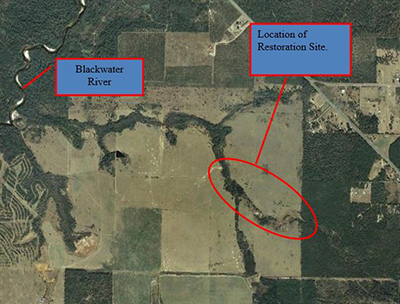
Yellow River Soil & Water Conservation District was contacted for assistance through The Land Conservation Assistance Network Site. Susan Holley responded and became a great partner in conservation. the US Fish and Wildlife Service in Florida collaborated on a habitat restoration project.
BACKGROUND
Many watersheds within the US Fish & Wildlife Service’s Northeast Gulf (NEG) ecosystem, comprised of SE Alabama, SW Georgia, and NW Florida, support a high species diversity which includes listed or rare mussels, fish, and other aquatics. Several watersheds have experienced degradation in recent years due to a variety of factors such as: aquatic species passage obstruction, increased sediment deposition caused by urban development, road construction, inadequate BMP installation and maintenance at stream crossings, elimination of natural buffers for silvicultural purposes and row-crop and cattle grazing operations, etc. As a result, several aquatic and buffer species are now or will soon be imperiled. In response to these threats, the NEG ecoteam has designated watershed restoration/enhancement as a high funding priority. NEG biologists have evaluated the condition of watersheds within the ecosystem and have classified primary needs, namely: 1) restoration, 2) enhancement, or 3) preservation. NEG Partners for Fish & Wildlife (PFW) biologists have utilized this classification to investigate and prioritize riparian buffer and in-stream restoration/enhancement projects. Those proposed project sites which support and/or provide benefits for listed and rare aquatic species, and provide connectivity within and between focus areas and species populations rank high on the project list. In regard to the Blackwater River watershed, the ecoteam has completed several projects that have benefited federally threatened Gulf sturgeon. The Unnamed Tributary which drains to Blackwater River and ultimately to East Bay, is winter resting area for Gulf sturgeon. The property in question supplies tons of sediment from the agricultural farming operation to the Blackwater River at the Bluff Landing. This Unnamed Tributary provides aquatic habitat for a plethora of amphibians (e.g., bronze frog, Apalachicola dusky salamander, three-lined salamander, red salamander), reptiles (e.g., loggerhead musk turtle, river cooter, spiny softshell turtle, snapping turtle, and mammals (river otters, beavers), fish, aquatic insects and mussels.
RESTORATION PLAN DESCRIPTION
Mr. Earl Thompson has requested technical and financial assistance to restore approximately 3,000 linear feet of severely impacted stream flow and restoration of gullies feeding from surrounding pasture to the Unnamed Tributary. The uplands surrounding the tributary is owned by the Thompson Family and has been used for agricultural practices, primary for cattle grazing since 1994. During that time, cattle use the creek as a primary source for water and has impacted the surrounding terrace and resulted in the massive failure of terrace slopes and channel stability. In the past years, sediment has blocked the creek’s natural flow during major rain events, thereby impacting upstream habitat. During low flow conditions, much of the hydrology is subterranean, impacting fish and aquatic bugs, and impeding fish passage and natural hydrology. In addition, the gullies along each side of the stream introduce large quantities of sediment effecting instream habitat and aquatic health. In addition, loss of floodplain function due to excessive sediment loads has created vertical and lateral containment of stream hydrodynamics. The proposed project would restore the natural stream channel within the gullied area and reconnect the upper and lower stream systems. This would include the removal of cattle access to the stream and restore the surrounding 9 acres of uplands and approximately 3 acres of wetlands along the stream corridor. Once cattle are removed from the 9 acres of upland habitat, regeneration of natural vegetation will be achieved. Approximately 3,000 linear feet of stream would be restored. Stream banks and in stream habitat would be reshaped and installed for proper fluvial geomorphic function. All extra fill and debris will be removed and the stream banks will be restored to their natural contours and slope. Eroded areas will be replanted with natural vegetation. As a component to restoring the stream channel, a permanent perimeter fence will be installed to exclude cattle from entering the project area. Areas that have gully erosion will be stabilized to eliminate loss of soil into the new channel. This will include grading, shaping, and contouring each upland gully area. Erosion control and native vegetation will be planted to stabilize the gully sites. Also, exotic species will be controlled with herbicide treatment. The project will eliminate significant siltation of the downstream portions of the tributary, greatly improving fish and wildlife habitat. We expect an increase in aquatic invertebrate and fish populations. The removal of this impediment will also eliminate a major long-standing barrier to the migration of fish and wildlife and restore the ability of microorganisms to move freely through the system.
CONTRUCTION PHASE
The proposed project is expected to begin within a few weeks of permitting and allowing for 3 months of project construction. Construction will include stream flow diversion around project area, floodplain creation and contouring, stream channel excavation, instream habitat structure placement, erosion control matting installation, native grass and tree plantings, and cleanup. We expect that following construction, installation of plant materials will depend on seasonal scheduling with March being the last month to successfully plant before warmer temperatures inhibits growth.
 Sign In
Sign In
 Sign In
Sign In
